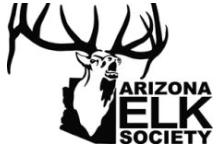Background information of the Arizona Elk Society.
VISION: "Arizona Elk Society is the premier organization for supporting habitat restoration for elk and wildlife."
MISSION: "The mission of the Arizona Elk Society is to benefit elk and other wildlife by generating resources for habitat conservation and restoration, and to preserve our hunting heritage for present and future generations."
In support of our mission we are committed to:
• Conserving and enhancing ... さらに詳しく
Background information of the Arizona Elk Society.
VISION: "Arizona Elk Society is the premier organization for supporting habitat restoration for elk and wildlife."
MISSION: "The mission of the Arizona Elk Society is to benefit elk and other wildlife by generating resources for habitat conservation and restoration, and to preserve our hunting heritage for present and future generations."
In support of our mission we are committed to:
• Conserving and enhancing wildlife habitat in Arizona.
• Protecting and promoting our hunting heritage.
• Promoting sound wildlife and habitat management through partnering with government agencies and other organizations.
• Implementing special programs for youth education regarding conservation, hunting and outdoor activities.
• Providing outdoor hunting experiences for Arizona’s wounded veterans
• Informing the general public about issues concerning wildlife conservation, as well as scientific and biological wildlife and habitat management.
ABOUT US:
The Arizona Elk Society is a group that was founded, in 2001, by hunters, elk and wildlife lovers, with the resolve to get involved in improving the numbers of elk in Arizona and improving and restoring the wildlife habitat in our State as well as protecting our Hunting Heritage for future generations.
Arizona has a diverse wildlife population but there are threats to the wildlife, their habitat, hunting and our ability to access the land. By uniting to fight these threats we strengthen ourselves to continue to protect the heritage we created.
The Arizona Elk Society recognizes the need for sportsmen to be represented at many levels, from boots on the ground to land and wildlife agencies and our Capital. We work daily on our programs that improve the quality of habitat that the wildlife needs to thrive. We are constantly looking for ways to educate and offer opportunity for the public, new hunters and youth to get involved. From our Water for Wildlife Program, Habitat Partners of Arizona Program, our new Hunts for Heroes wounded veterans Program and our Youth outdoor Skills Program we are supporting, protecting and improving Arizona’s Outdoor Heritage.
Features of the Arizona Elk Society towards our Mission:
1. Allotment acquisition: The AES has worked with the Forest Service, Arizona Game and Fish Department and the livestock industry to acquire grazing allotments that have been set aside for natural resource conservation. While the allotments were very important elk habitat to the areas the AES takes a much broader view of the natural world than simply elk and their habitat. All three of the acquisitions contain important waterways/riparian habitat that with improved management and protection from overutilization will become important recovery areas for fish and wildlife that need intact habitat for their survival. After acquisition by AES, and many of the habitat projects completed or planned, all species are offered a better home than they had under prior management schemes. In total, over 100,000 acres have been acquired by AES for natural resource conservation.
2. AES Water for Wildlife, water management program: Wildlife waters are an important habitat feature for all wildlife species. Although some detractors to this program like to paint the picture that the AES and other like-minded organizations maintain waters solely for elk, the data strongly refute this contention. Recent research on the topic pointed out that in one study area, the number of non-hunted species that use these habitat features outnumber the number of hunted species that visit. AES is the frontrunner of organizations that work with agencies/landowners/ranchers to improve water availability during times of drought to ensure that elk, bats, birds, amphibians and others have access to reliable water to ensure their survival. In 2012, we expended nearly $88,000 and created new storage capacity of about 5.0 million gallons of water for wildlife. In 2013 the Arizona Elk Society created a volunteer catchment repair squad to repair, refurbish and maintain hundreds of wildlife water catchments to benefit elk and other wildlife. In 2013 we repaired over 30 catchments, in 2014 with funding raised at our annual Banquet we repaired and maintained over 45 catchments. For 2015-16 we have worked with the AZGFD and USFS to identify over 100 catchments that will be repaired. Many of these catchments have not worked in many years due to neglect.
At the same time we are repairing water catchments our crews are hauling water throughout the drought area for elk. In 2014 our water crews hauled over 200,000 gallons of needed water.
3. Represent Sportsmen and Comment on various environmental documents: With the advent of the National Environmental Policy Act (NEPA) one of the key legal aspects of natural resource management is the disclosure of the impacts that actions will have on the natural world. The AES is one of the most active organizations in preparing comment on these documents for the broader hunting/fishing public that would otherwise have no voice in the debate. The AES has been active in forest management programs such as the Four Forest Restoration Initiative (4-FRI), forest management plans, species management such as the Mexican gray wolf and jaguar, and travel management rules.
4. Youth conservation education: This is a critical aspect of what AES does. We hold numerous youth outdoor skills camps as well as many mentored hunting camps. America has experienced a near complete transition from a rural-oriented country to one of being very urban. In Arizona, this is unfortunately as true as anywhere. Many youth have no opportunity to experience the outdoors and form an underpinning of an environmental ethic. One of the goals of the AES is to make youth aware of the opportunities that await them in the outdoors, but every bit as important is the ability to make these youths aware of the importance for natural resource conservation.
5. Wildlife Habitat Projects: The AES is again the leader in this area as the projects that we do are large-scale with generally hundreds of volunteers at each project.
As an example, the organization has worked tirelessly on the Burro Creek Allotment (one that they purchased) to remove 100 mi. of hazardous barbed wire fences. These fences are a hazard to entangling wildlife and people that stumble upon these debilitated fences, thus the forest is safer for critters and the public. Invasive species removal – in the last five years, the AES has been instrumental in the improvement of thousands of acres of grassland and riparian habitats by the removal of invading plant species. Grasslands are often referred to as an endangered habitat in Arizona as the lack of fire and other disturbances allow many woody species to invade the grassland. These grasslands serve as wintering habitat for elk, and are year-round habitat for many non-hunted species as well as some that are hunted.
Riparian habitat protection – this is done not only by the acquisition of allotments but by habitat improvement projects as well. One of the key impacts to this community is the expansion of conifers into the riparian areas and the meadows that serve as sponges that hold water in wet periods and slowly leaking water into the streams that are so important to many species. The problem with these invaders is that they use water that otherwise would end up in the streams. Importantly, these trees did not occur in the areas where we work now but lack of fire has facilitated their development in the riparian corridors. AES, in cooperation with the Forest Service have been removing trees along the riparian corridors at the Buck Springs Allotment with an estimated removal of well over 100,000 small diameter trees from the area. Another important aspect of the removal of these trees is that with their absence, the chance of a catastrophic fire is reduced. Again, it is important to point out that these efforts benefit not only elk, but native fish, Mexican spotted owls, wild turkeys, and others.
Riparian Stream Restoration/Erosion control – many of Arizona streams have been degraded by vegetation decline that has allowed erosion in riparian corridors. What happens is that the vegetative cover that slowed water flows has decreased so that in times of high flow, water velocity is greater than normal and at points of the stream, erosion occurs. This is a situation that left unrepaired will worsen in time, with the water table lowering in these important meadows. The AES, in cooperation with the Forest Service is working on several sites where this has occurred and has been using rock and tree gabions to allow these critical impacts to heal and improve the riparian conditions. With training and support from the Forest Service the Arizona Elk Society has become and leader in riparian stream repair. Many miles of stream repair has been accomplished at our volunteer work projects. One of the many benefits is increased water shed to lakes and communities downstream.
Riparian Meadow Protection – for the last few years, working with the Forest service and AZGFD, the AES has completed many projects to build log fencing to protect critical riparian meadows from off road travel. Protecting these areas allows wildlife to return to these meadows for forage and water without the disturbance of recreation vehicles. Many of these projects have been accomplished by the AES working with the Boy Scouts of America to provide wildlife conservation projects for Eagle Scouts in Arizona.
6. AES Hunts for Heroes, hunting experiences for Arizona’s Disabled Veterans.
In 2015 the Arizona Elk Society started this program to offer hunting experience to Arizona’s disabled veterans. In 2015 we completed 37 hunts and are on track in 2016 to do 45+ hunts. We provide everything to the veterans at no cost for a 3-4 day hunting experience.
テキスト全文を非表示
